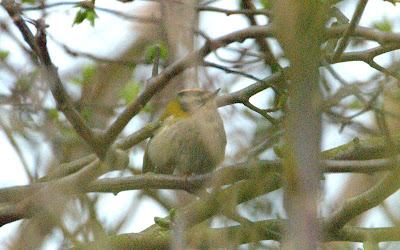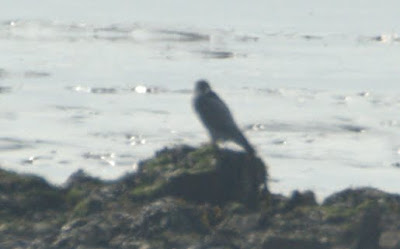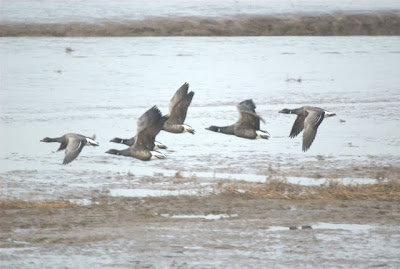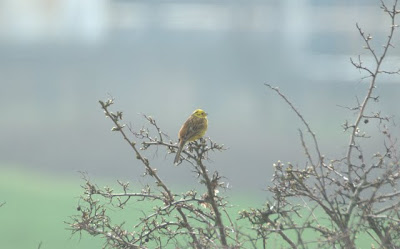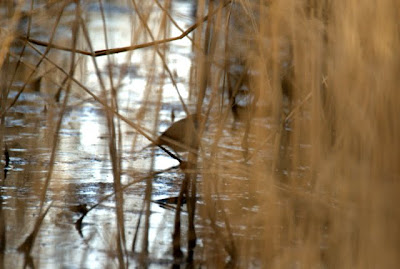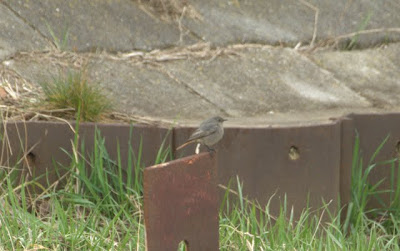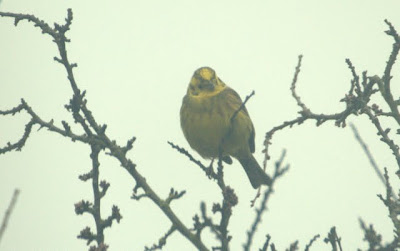Was at my site in North Lincolnshire yesterday. Forgot my camera sadly but the weather was crap so the photos would have been worse than the usual dross. Yes really. Highlights were few with no colour rings of Black-tailed Godwits and numbers down generally. Two Grey Partridges on the pidgey salt marsh were a surprise although I have seen Red-legeed here and my trip to Titchwell last month should have taught me to expect anything where these guys are concerned.
On the wader front, my first Knot in ages on site was a nice surprise although it was an aberrantly plumaged bird (was trying to turn it into a Great Knot for 30 minutes). Bar-tailed Godwits were the star of the show. Very few winter on the middle estuary but there seems to be a decent spring passage and they were easily the commenst wader at high tide. And well thats it. Its was raining and damp. I did however very much enjoy listening to the cricket. Well done to the Indians and it was good to hear Pakistan being competitive again after all the strife that they have gone through. Bring on the final.
Thursday 31 March 2011
Monday 28 March 2011
Declines in House Sparrows
Today I was catching up on Charlie Moores' Podcast series Talking Naturally when I came across the 2 part podcast on Sparrowhawk predation as a cause of House Sparrow decline. Normally I switch off at the mention of mundanities, only recently have my bird watching urges been supplemented by conservation related thoughts, but the author being interviewed was an extremely interesting character.
Before I plough on may I mention that I have not read the thread on birdforum and have no intention to do so. Dr Chris Bell comes across as a maverick, someone for whom the idea of convention is anathema but in his bid to prick the pomposity of presumed wisdom manages to unveil a very large ego. In short this is a man who is sure of himself. Despite this, likeability is not the foremost pre-requisite of being a good scientist. Being good at science is. Having listened to the podcasts I have heard the layman's account of the science and the opinion aired by the aforementioned. I thought it wise to seek out the paper where the science is entombed to make my own judgement on its methods and conclusions.
I have had a brief skim through to acquaint myself with methods and discussion. There seems little argument can be had with the survey methodology. Bird census techniques are well established and these seem reasonable. Ish. Weekly counts of mean numbers of sparrows? Presence of Sparrowhawks indicated by seeing them at the feeding station more than once? On the first count - integrating ringing schemes to see how counts relate to actual numbers of sparrows. Also - counts of other species at feeding stations would be useful as these would show what proportion of the bird table population is made up by sparrows and as such whether they are preferentially predated. Liklihood would suggest that other bird table species of similar size and diet would be impacted equally by the introduction of a new predator and yet Chaffinch, Greenfinch and Goldfinch numbers all increased in the survey period (although Greenfinches are now suffering due to Trichomoniasis). Counting presence or absence of Sparrowhawks by their attendence of bird tables is a huge bias - what if Sparrowhawks are present but dont attend bird tables? How would you count them and include them in the data - you can't.
The modelling of populations is reasonable. There is a direct negative correlation in Sparrow numbers with increasing Sparrowhawk numbers but this doesn't equal cause and effect. Other 'accepted' reasons for decline are debunked by short shrift rather than by exploring the evidence base. An effort to seek out papers poorly illustrating decreasing invertebrate populations and a lack of correlation with farming intensification must be made to reinforce the point. Just by saying something doesn't exist does not make it true. It is up to the author to disprove preconceived wisdoms. The argument counter to this is that the paper only explores relationships between sparrows and sparrowhawks. The key word in that is relationship and it indicates a desire to go deeper than simple correlation and yet the paper fails to do this. At no stage in the paper is there a mention of any other factors such as the increase in other predators either avian or mammalian. Where is the interpretation of the impact of corvids or pet cats or grey squirrels? Also if you replaced the work Sparrowhawk in the paper with Buzzard or Peregrine then it would still be broadly correct except neither of these predate garden birds.
So if it was accepted that the modelling and surveying was correct - what of the findings? That Sparrowhawks are THE cause of House Sparrow declines. Maybe that would be fair and I am not suggesting it couldn't be the case. This paper merely puts it forward as a potential case. I have heard it suggested that after many years of no predation, urban sparrows have lost some of their more discrete behaviour and subjective observation suggests that sparrows now are increasingly wary. Perhaps the arrival of Sparrowhawks is a selection event disposing of the fat, chirrupy sparrows sat upon your roof to the benefit of wiry, wary sparrows in your hedge? There may be a 'bounce' back. An analysis of sparrowhawk diet may well indicate preferred food (I am sure there will be research on this but the post is more stream of concious than proper essay) and thus looking at how other prey species are faring in relation to sparrows may be profitable.
At the moment Sparrow numbers continue to decline and Sparrowhawk numbers are plateauing and perhaps in a slight decline after reaching near saturation levels. Whether the limiting factor is persecution, prey resource or habitat I am unsure (a brief scan of research suggests recruitment of juveniles is reduced when prey levels decline but the paper I have seen was Goshawk).
So Sparrows eh? They used to occur in plague like proportions and yet they didn't when Sparrowhawks first came back. A lack of solid evidence leads to this being refuted but anecdotes suggest that Sparrows were more plentiful in London in 1900 than 1970 and yet this decline cannot be attributed to Sparrowhawks. This again leads us to look at the relationship as correlation not anything more? Or perhaps the Sparrowhawk predation is the straw that broke the camels back with those birds best able to persist under the resident pressures at increased likelihood of predation?
Thats the science-y stuff I guess. In no means comprehensive and please realise that it was written as it occurred to me without draft or structure (I work and have a child...need free time). Now for the moral, human and conservation-y stuff.
1) Is there a reason why tonnes of sparrows are good?
2) Will Sparrowhawks cause the extinction of Sparrows?
3) Is having more Sparrowhawks and less Sparrows good/desirable?
4) Do fringe populations of sparrows have any relevance. Rural and urban sparrows were sampled but not those in rurban areas where birds are likely to have more nesting sites, feeding sites & access to invertebrates & water? Are these the mythical sink population?
5) Does Chris Bells opinion that its all Sparrowhawks cloud his objectivity and undermine his science?
6) Why does the RSPB/BTO refuse to acknowledge the work despite it being published in an established journal?
7) Is Chris Bell a puppet for songbird survival and anti-raptor pressure groups?
My personal opinion on the matter is that I don't want Sparrowhawks to be the culprit. This colours my judgement and thus you should be aware of it. I also believe that Sparrowhawks are likely to be a predator of Sparrows but suggest that cats are the pre-eminent cause of Sparrow predation. Pure numbers must win out with 150,000ish Sparrowhawks vs several million cats. Not all Sparrowhawks are in contact with Sparrows but almost all cats will share their territory with sparrows or former haunts of sparrows. Nest predation by corvids/parakeets/woodpeckers/grey squirrels (god I havent mentioned burgeoning numbers of parakeets in london - they must have exploded as sprawks arrived in london!) could well be a factor as all of these have increased since 1970. I believe in predator prey models and whilst sparrowhawks may switch targets when sparrows run short they will strike a balance and more resilient sparrows with a more balanced ecology will return in the long run. I dont believe that in a healthy biodiverse community masses of sparrows are a good thing. They indicate a depleted ecosystem the same as poluted estuaries are home to massive monocultures of tolerant organisms such as some ragworm species. I think those populations of house sparrows that continue to blossom should be looked at the presence absence and relationship with sparrowhawks should be investigated. They do exist - I get tonnes of spadgers in my garden. Chris Bell is probably not a puppet for songbird survival et al but he has some sympathies for them and in terms of his research he definitely has a degree of anthropomorphism going on with the 'poor little sparrows'. The BTO & RSPB have made blaming raptors for this sort of decline almost impossible and in order to remain relevant and credible they need to address this research ASAP fully and with respect as it is credible work despite its weaknesses.
Any comments are welcome. I may make some more if ideas occur...
They might not.
Friday 25 March 2011
At Last
I finally, finally managed to catch up with a Firecrest today.
It has been my biggest UK tart for a long time so when an early finish allowed me to get down to Spurn I took it and was damn pleased!
Yesterday was a good days surveying with 9 Whooper Swans at Patrington along with several hundred Dark-bellied Brent Geese. A Peregrine passed through unnoticed and perched on the floodbank.
It has been my biggest UK tart for a long time so when an early finish allowed me to get down to Spurn I took it and was damn pleased!
Yesterday was a good days surveying with 9 Whooper Swans at Patrington along with several hundred Dark-bellied Brent Geese. A Peregrine passed through unnoticed and perched on the floodbank.
Today I was at Sunk Island, a few miles from Patrington. Before leaving I managed a couple of Chiffchaffs in the garden. Arriving at Sunk Island I was greeted by the birding regulars including Garry Taylor. The counts for the survey were poor but whilst rambling about I found a Brambling, Little Egret and best of all a Sand Martin. Whilst I was ambling back for my last count 2 Short-eared Owls started fighting over the saltmarsh. They even called - not something I had heard before.
Decamping to Spurn at last orders had its effect as I managed to refind the Firecrest along with a Swallow. Very pleased with myself and like the Bluethroat another bird I had only seen briefly before abroad.
Wednesday 23 March 2011
Dishcloth
Today was as dull as the proverbial dishcloth. I spent the majority doing a disturbance survey in Lincolnshire, totally 20 birds and only 1 instance of disturbance in 8 hours. Despite this, it was a pleasant day, with a warm sun and plenty of singing passerines. Both Reed Bunting and Yellowhammer took turns to use a song post, whilst Meadow Pipits and Skylarks song flighted. Allied with the resident mipits there was a decent pulse of migrants mid-morning, joined by a few Pied Wagtails and a single Grey Wagtail.
On my way to work this morning I had a nice Fox silhouetted against the rising sun on top of a hillock before a Barn Owl displaced it. Still no migrants - not a hirundine over the river nor a chiffer in the trees. Gah! Tomorrow I'm at Patrington Haven & Welwick saltmarsh so I may get some decent stuff. I may not though...
P.s. I thought I was weird as a birder but you should see the ship watchers.
On my way to work this morning I had a nice Fox silhouetted against the rising sun on top of a hillock before a Barn Owl displaced it. Still no migrants - not a hirundine over the river nor a chiffer in the trees. Gah! Tomorrow I'm at Patrington Haven & Welwick saltmarsh so I may get some decent stuff. I may not though...
P.s. I thought I was weird as a birder but you should see the ship watchers.
Tuesday 22 March 2011
Holbeach-ringed Godwits
Ringing Returns
I have just had a host of colour-ringed Icelandic Black-tailed Godwit sightings processed. I have converted them to Google Maps for some easy viewing.
Bird 1 was ringed in Northern Iceland in June 2006 as a chick. It has been seen sporadically over the next 5 years on the French Atlantic coast and in Essex & Lincolnshire.
View RO-LR in a larger map
Bird 2 was ringed as a chick in July 2007 and has been seen for long periods in North Norfolk as well as on the humber (where I have recorded it twice) & in a different area of Iceland to its natal area plus atlantic France.
View RO-LRflag in a larger map
Bird 3 was seen by my boss in March last year at Paull Holme Strays and is a younger bird, being ringed as a chick in Iceland in 2009. It has only been recorded in eastern England with sightings on the Humber as well as at Cley Marshes and Welney, Norfolk.
View RY-RRflag in a larger map
Bird 4 was originally ringed as a pulli in 2009 and has been recorded many times on the humber with an additional sighting at Boyton Marshes, Suffolk.
View RY-YRflag in a larger map
I have another couple of birds to draw maps up of. These were English ringed Icelandic birds so I will post them soon.
Bird 1 was ringed in Northern Iceland in June 2006 as a chick. It has been seen sporadically over the next 5 years on the French Atlantic coast and in Essex & Lincolnshire.
View RO-LR in a larger map
Bird 2 was ringed as a chick in July 2007 and has been seen for long periods in North Norfolk as well as on the humber (where I have recorded it twice) & in a different area of Iceland to its natal area plus atlantic France.
View RO-LRflag in a larger map
Bird 3 was seen by my boss in March last year at Paull Holme Strays and is a younger bird, being ringed as a chick in Iceland in 2009. It has only been recorded in eastern England with sightings on the Humber as well as at Cley Marshes and Welney, Norfolk.
View RY-RRflag in a larger map
Bird 4 was originally ringed as a pulli in 2009 and has been recorded many times on the humber with an additional sighting at Boyton Marshes, Suffolk.
View RY-YRflag in a larger map
I have another couple of birds to draw maps up of. These were English ringed Icelandic birds so I will post them soon.
Monday 21 March 2011
Bluethroat!!
 |
| Bluethroat, Spurn |
I shot down to Spurn and arrived about 15.20. As I arrived 4 other guys were knocking about and they said they were getting views regularly although brief and inflight. I was quickly treated to views like this but not enough to tick. One of the gents (who was nice enough, dont get me wrong) was complaining at the top of his voice that the bird wasnt showing well. He continued until I got a better view and everyone hushed. Not surprisingly the little gem came up the ditch to within 8 feet. Wonderful views were had but it was thick reeds so photos were difficult, allied with dipping light and the elusive nature of the bird and the fact I had to put the camera into manual focus meant that I struggled a little. Below is a shot that highlights the views.
Eventaully the loud chap and his mate pushed off. I lay down and the bird came in beautfiully to about 6 feet or so working side to side in the ditch, occasionally stopping in the middle and feeding well allowing me my
opening photo. Although hazy and partially obscured you can make out the most interesting feature - the white-spot. But why the interest?Its a bit more complex than this but March Bluethroats tend to be White-spotted Bluethroats - Luscinia svecica cyanecula. These are continental birds which overshoot rather than the red-spotted birds which were formerely pretty common drift migrants in May returning to Scandinavia. Interestingly they have different ecological niches, leading to differing behaviour. Excuse me here as I am going to grossly oversimplify but cyanecula are birds of reedbed - skulky and difficult to see whilst svecica breed in more open areas and are more prone to being seen on marshes and the like, in the open. Thus white-spotted is both rarer and harder to see. This bird constitutes the 3rd record for Spurn and the first in 45 years for this subspecies. It has been aged as second calender year by the contrast on the spots on the primary coverts. Not a feature you can see in my photos sadly...
It is a British and Yorkshire tick for me so Im pleased on that score as well plus its a grip-back on John Sadler who was running away in a little competition between him, myself and Mike Richardson. Good news. I'm back surveying in Lincolnshire on Weds/Thurs/Fri so hopefully will have some fodder for you then.
Mixed
I have had an interesting few days from Friday through to today. Nothing too thrilling but the survey went well on Friday, Saturday had one of the Guinea Pigs escape from the run as I put them out. He still hasnt turned up as he legged it under the fence and along the drain to next doors decking. Sadly I think that might be that...
Yesterday was a friends leaving do as he is headed to Australia shortly to work as a Brain Injury nurse. Me and Angela ditched the baby at my parents house and went for a meal pre to the rather glorious assembly rooms in York which house the local branch of ASK. Lovely setting - awful food - I went for the Vesuvio Pizza (lots of Chilli) which I have had on a couple of occasions before but this was like the chef was taking the piss. I have had less spicy madras's. I love a spicy meal but this was just painful and I was deeply disappointed. Nevermind. Definitely go for the setting though. Grand and opulent were words designed to encapsulate it. Later on we met up with Mark and Ally in the Vudu Lounge, a swanky bar in the quarter. Very nice it was too although my 3.30 get up with the child was haunting me after 4 pints of beer and we decided to head off and try as I might I was snoring for a large part of the journey home. Thanks for the lift honey!
Back to Friday - I decided to zip down to see the Black Redstart at Water's Edge, Barton-upon-Humber before my survey. I guess this almost counts as a migrant! Checking it out it seemed to be a 1st winter male (white in the wings but without the mask) although I have actually done any research on this. It showed well perched up on boats and posts before dissappearing. This was my cue to leave as well and pushed on to my survey site.
The survey was busy enough with a few hundred Black-tailed Godwit and plenty of other waders knocking about. The Shelduck were also out en masse and a few Oystercatchers were dotted about staking territory and generally looking highly sexed.
Checking the lagoon out and the Avocets had returned with a minimum of 18 present. this was by far my highest count here - breeding perhaps? No sign of any LRP's yet although next month may yield a better result (it will also be my last visit). Fingers crossed.
I was going to visit Spurn for the White-spotted Bluethroat today but I am stuck at home wasting my time in Lieu as we have a leaky pipe. Doh!
Yesterday was a friends leaving do as he is headed to Australia shortly to work as a Brain Injury nurse. Me and Angela ditched the baby at my parents house and went for a meal pre to the rather glorious assembly rooms in York which house the local branch of ASK. Lovely setting - awful food - I went for the Vesuvio Pizza (lots of Chilli) which I have had on a couple of occasions before but this was like the chef was taking the piss. I have had less spicy madras's. I love a spicy meal but this was just painful and I was deeply disappointed. Nevermind. Definitely go for the setting though. Grand and opulent were words designed to encapsulate it. Later on we met up with Mark and Ally in the Vudu Lounge, a swanky bar in the quarter. Very nice it was too although my 3.30 get up with the child was haunting me after 4 pints of beer and we decided to head off and try as I might I was snoring for a large part of the journey home. Thanks for the lift honey!
Back to Friday - I decided to zip down to see the Black Redstart at Water's Edge, Barton-upon-Humber before my survey. I guess this almost counts as a migrant! Checking it out it seemed to be a 1st winter male (white in the wings but without the mask) although I have actually done any research on this. It showed well perched up on boats and posts before dissappearing. This was my cue to leave as well and pushed on to my survey site.
The survey was busy enough with a few hundred Black-tailed Godwit and plenty of other waders knocking about. The Shelduck were also out en masse and a few Oystercatchers were dotted about staking territory and generally looking highly sexed.
Checking the lagoon out and the Avocets had returned with a minimum of 18 present. this was by far my highest count here - breeding perhaps? No sign of any LRP's yet although next month may yield a better result (it will also be my last visit). Fingers crossed.
I was going to visit Spurn for the White-spotted Bluethroat today but I am stuck at home wasting my time in Lieu as we have a leaky pipe. Doh!
Labels:
Avocet,
Black Redstart,
Lincolnshire,
North Killingholme
Thursday 17 March 2011
Survey Mega!!
No, not really. I did see a Black-headed Gull though. Truely awful. We recorded 9 species, Dunlin, Turnstone, Redshank, Curlew, Common Gull, Herring Gull, Shelduck, Ringed Plover and the aforementioned BHG's. Not only was there no diversity BUT they were almost all in less than double figures across 8 hours. Truely crap. A few singing Skylarks and a displaying male Reed Bunting provided light relief. Ho-hum...
Called in on the Rough-leg. Dipped. It was seen a few minutes after we left. We did catch up with a single distant Marsh Harrier plus a small group of Avocets. Rest was standard.
Tomorrow its another day. Fingers crossed for a bit more success.
Called in on the Rough-leg. Dipped. It was seen a few minutes after we left. We did catch up with a single distant Marsh Harrier plus a small group of Avocets. Rest was standard.
Tomorrow its another day. Fingers crossed for a bit more success.
Saturday 12 March 2011
Wednesday 9 March 2011
Working as a Ornithologist
Please excuse this slightly self indulgent posting. I was thinking today what makes a decent ornithologist, how I came to enter the field and the bearing of being a good birder. Many of my birding peers would suggest that I am not the greatest birder and that would be fair. I am an inexperienced birder - I restarted as an adult aged 22 in 2004 so I have only been birding 6 1/2 years but almost immediately as I started I realised that this was what I wanted to do. I wanted to be a professional bird watcher and I guess to some extent thats what I do - very much a practical job. I got lots of birding experience very quickly and put effort into learning how to be a decent birder but time was needed. I quickly started my ornithology degree and whilst on that really pushed my experience as well as twitching and developed my love of migration.
In addition to my birding I pushed really hard at my degree, learning avidly on a number of subjects including marine ecology which has become my lesser speciality. Despite getting married in my first year (just after exams), moving in my second year (the day of an exam) plus having a baby on the way through the finals of my third year I was extremely chuffed with my degree, 69.4% (missed a 1st by 6 marks across the whole thing). As I finished my degree I gained experience doing seabird surveys and volunteering at my local nature reserve. At the end of my degree I started to feel able as a scientist and had a paper published and in synchronicity to this my skills as a birder were starting to leave beginnerdom and get to one of moderate skill. I don't claim to be an expert but I have worked VERY hard at improving.
When I got my job at the University they needed a birder/scientist and I was the only one they knew who was ready made to come in and survey for them - seabird surveys. For me it was right place, right time. I made sure that the right people knew me. In the year since I started full time my seabird ID has improved massively, ageing, sexing etc the common birds we come across and enjoying the learning experience. I am an expert in my field now - running offshore bird surveys and writing them up. Every day at work I strive for new opportunities and I now do some terrestrial bits and pieces as can be seen from my various blog pieces. Every day I am grateful that my junior school teacher was right when she suggested that I would be a marine biologist or ornithologist. I am both - only a beginner. Very much a beginner but I get to do this full time. I have some goals that in the short and medium term I need to start chasing to fulfill my long-term goals. The aim of this post isn't to say 'haven't I done well'. I know I have but I wanted to highlight to other birders, not just the experts, that if you have a science bent and love birding plus enjoy really pushing yourself, it IS possible to be a professional birder in a different sense to the conventional tour leader/photographer type that is typical. Take a risk, make a plan, chase hard, execute. I love it.
P.S. I challenge anyone to a no optics seperating Guillemots & Razorbills in flight - off. I am the daddy. I'm ready for my Brunnich's.
 |
| Not sure it suits me but I worked damned hard for it. |
| Not me but you get the idea! |
When I got my job at the University they needed a birder/scientist and I was the only one they knew who was ready made to come in and survey for them - seabird surveys. For me it was right place, right time. I made sure that the right people knew me. In the year since I started full time my seabird ID has improved massively, ageing, sexing etc the common birds we come across and enjoying the learning experience. I am an expert in my field now - running offshore bird surveys and writing them up. Every day at work I strive for new opportunities and I now do some terrestrial bits and pieces as can be seen from my various blog pieces. Every day I am grateful that my junior school teacher was right when she suggested that I would be a marine biologist or ornithologist. I am both - only a beginner. Very much a beginner but I get to do this full time. I have some goals that in the short and medium term I need to start chasing to fulfill my long-term goals. The aim of this post isn't to say 'haven't I done well'. I know I have but I wanted to highlight to other birders, not just the experts, that if you have a science bent and love birding plus enjoy really pushing yourself, it IS possible to be a professional birder in a different sense to the conventional tour leader/photographer type that is typical. Take a risk, make a plan, chase hard, execute. I love it.
| Any takers? |
Monday 7 March 2011
Collective Noun
Does anybody know the collective noun for Yellowhammers? A cheese of Yellowhammers? A lemon of Yellowhammers perhaps. Who knows? I only ask as I could have applied it to my garden today when at least 5 birds were present amongst the Goldfinches. I managed a quick snap of one of the two males, although my camera steamed as I had left it in the car...
Also as promised a few photos from the 'Great Voyage'
 |
| Multi-cultural |
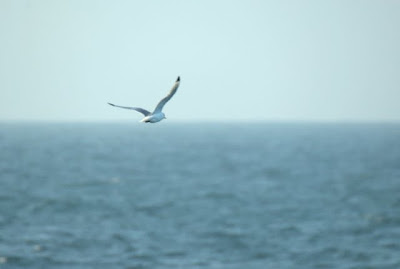 |
| Some Sea |
 |
| intermedius Lesser Black-backed Gull |
I did go to have a bash at the North Landing Lapland Buntings but was foiled as I was wandering round Breil Nook - my daughter was poorlyish, could I come quick to cheer her up/look after her. You may wonder why I wasn't doing that myself - I managed to negotiate a morning to chill and recuperate post voyage. Here is a Starling from North Landing.
 |
| Breeding Plumaged male |
Labels:
Garden,
intermedius,
Kittiwake,
LBBG,
Lesser Black-backed Gull,
North Sea,
Starling,
Yellowhammer
Sunday 6 March 2011
North, See?
The wind was in the North and yet I was bobbing about somewhere in the southern North Sea. Due to stuff beyond my control I cant say where but can reveal that at one point we were able to see dutch water. I was joined by a cantankerous Scot, an enthusiastic native of Suffolk and one of the lasses at work plus a host of British and Polish crew. The weather held and we had a very good survey for March.
I had had a 'bug' prior to going away and for obvious reasons am a little cautious when my alimentary canal is playing up at sea. Fortunately I needn't have worried as my 100% spew free record at sea remains unblemished.
2 days was the sum total of time bobbing and we worked every moment of daylight. This led to some excellent sightings, pride of place for me was mid-morning on the second day - an adult dark morph Pomarine Skua sans spoons, for all the world looking like a compact Bonxie which is what at 3 metres distance I initially called it as not expecting anything else. A touch of perspective showed it was uniform chocolate brown with a more compact shape (not a flying barrel). It hung around off the back before clearing off. This was only my second Pom and my first on survey so I was dead chuffed.
Other highlights included a couple of small skeins of departing Dark-bellied Brent Geese which tallied with the mass exodus to the continent we had been alerted to. Good numbers of Red-throated Diver moved mid-morning both days and amongst these was a single Black-throated Diver. The usual suspects were about with a large passage of intermedius Lesser Black-backed Gulls occurring.
The painful bit of the survey is evaluating what I missed, not too bad this time - 2 Little Gulls and a small group of Little Auks were the best while the rest is headed up by a Puffin. Little Auk is annoying as its not a guarenteed year tick but the others I will let slide...
We arrived back at Hull this morning at 6 and subsequently my intestines rebelled. Off the boat thankfully...
I had had a 'bug' prior to going away and for obvious reasons am a little cautious when my alimentary canal is playing up at sea. Fortunately I needn't have worried as my 100% spew free record at sea remains unblemished.
2 days was the sum total of time bobbing and we worked every moment of daylight. This led to some excellent sightings, pride of place for me was mid-morning on the second day - an adult dark morph Pomarine Skua sans spoons, for all the world looking like a compact Bonxie which is what at 3 metres distance I initially called it as not expecting anything else. A touch of perspective showed it was uniform chocolate brown with a more compact shape (not a flying barrel). It hung around off the back before clearing off. This was only my second Pom and my first on survey so I was dead chuffed.
Other highlights included a couple of small skeins of departing Dark-bellied Brent Geese which tallied with the mass exodus to the continent we had been alerted to. Good numbers of Red-throated Diver moved mid-morning both days and amongst these was a single Black-throated Diver. The usual suspects were about with a large passage of intermedius Lesser Black-backed Gulls occurring.
The painful bit of the survey is evaluating what I missed, not too bad this time - 2 Little Gulls and a small group of Little Auks were the best while the rest is headed up by a Puffin. Little Auk is annoying as its not a guarenteed year tick but the others I will let slide...
We arrived back at Hull this morning at 6 and subsequently my intestines rebelled. Off the boat thankfully...
Tuesday 1 March 2011
Youth Re-visited
I was in Tesco today and amongst the crap £3 CDs I found the greatest hits of the Kinks & Faithless - both well cherished tape based memories of being 16 with a mix of mod & euphoric dance driving my hormone addled attempts to attract girls. Failures mostly at that time. Hazy memories of Ben Sherman shirts, cream combats, mad dog 20/20 and marlboro lights. The sound of the following 2 records conjure all this and more.
ps going to the southern north sea over the weekend. Hopefully we get something good for that.
ps going to the southern north sea over the weekend. Hopefully we get something good for that.
Subscribe to:
Posts (Atom)
How birds and brains become mutually exclusive

